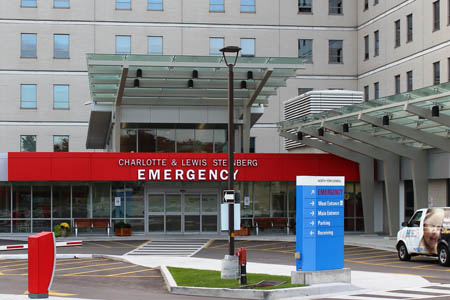COVID in the ED: Through the eyes of an Emergency Department physician

When you imagine a typical visit to the Emergency Department (ED), it likely involves crowded emergency rooms, a lengthy triage process, and long wait times. To help alleviate ED pressures, experts in health care regularly track trends and data to predict busier periods so they can plan for higher patient volumes, like during flu season, for example. Preparing for a global pandemic like COVID-19 is not as straightforward.
Emergency Department teams are now largely treating those with respiratory symptoms, while others have shifted their efforts to COVID-19 assessment centres. Clinical staff are greeting patients from behind plated glass, wearing masks and face shields. But, in the midst of this unprecedented challenge is some familiarity for health care workers – their commitment to care and ability to adapt to change.
Dr. Elisha Targonsky, a physician in the Charlotte & Lewis Steinberg Emergency at North York General Hospital (NYGH), is now regularly treating patients with symptoms related to COVID-19 – as we now know the virus is transmitted in the community and not just by those who have travelled.
“We know that older people and those with underlying health conditions like heart, lung and kidney disease are at an increased risk. However, even those who are young and healthy can become seriously ill,” says Dr. Targonsky.
Dr. Targonsky believes the key to controlling the spread of the global outbreak is minimizing transmission through isolation and social distancing.
“This means we should only be in close proximity with our immediate family, which can be especially challenging during upcoming holidays. Social distancing doesn’t mean we should be going for walks in crowded areas or playing sports in a nearby park, or going to the grocery store more than we need to.”
If you have mild respiratory symptoms that are similar to COVID-19, Dr. Targonsky suggests isolating yourself from loved ones, even if you have not been tested.
“While we’re still learning about the presence and transmission of the virus, there is data to suggest it can be spread without any symptoms, so you may be able to unknowingly pass it. If we adhere to social distancing measures and take all precautions, including regular and proper hand washing and not touching our faces, we will reduce the number of deaths. But we need everyone to play a role,” adds Dr. Targonsky.
Treating COVID-19
While many cases of COVID-19 can be managed under quarantine at home, some may need medical intervention. One indicator is shortness of breath, says Dr. Targonsky. It’s important people seek emergency care if they have difficulty breathing. Go to your nearest emergency department or call 9-1-1.
“Ideally we want everyone to take precautions and be vigilant. If there are too many people getting sick, it is going to put added pressure on our hospitals and already strained system. Preventing people from getting sick is of the utmost importance right now.”
If you or someone you know might have COVID-19, you can access the free online assessment tool. For more information about how NYGH is tackling COVID-19, please visit our website.
